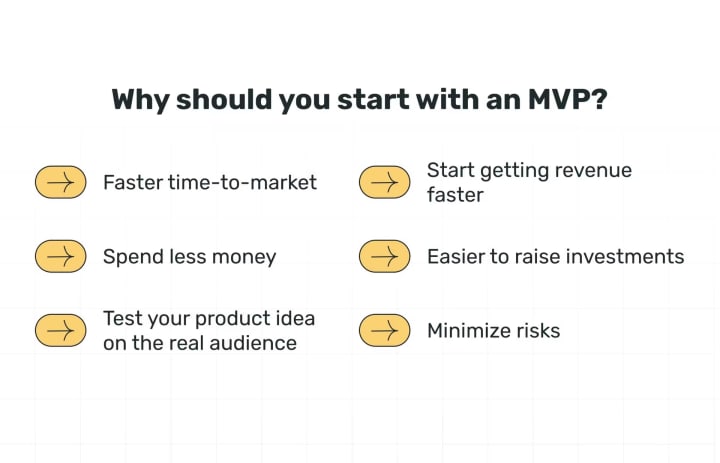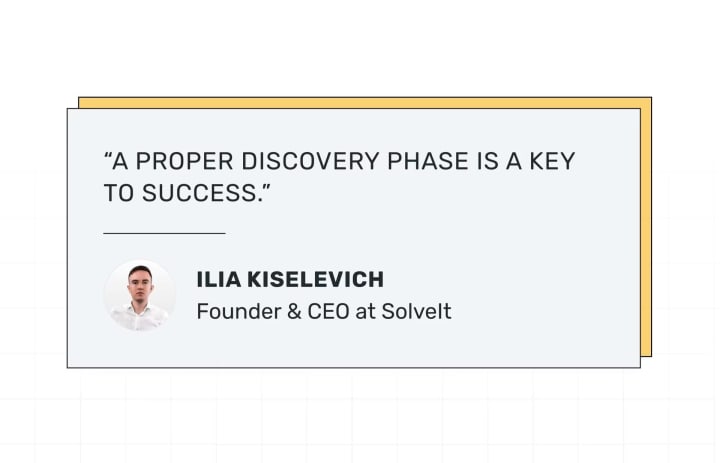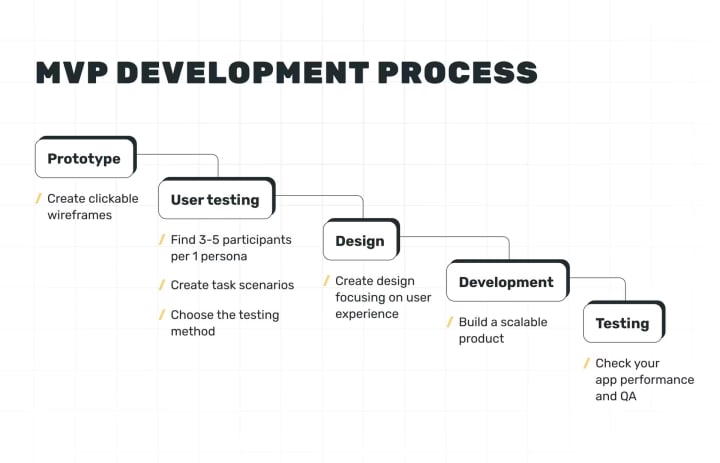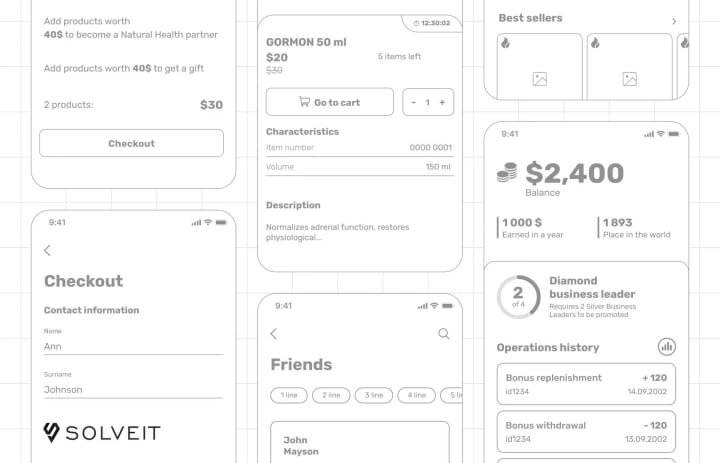MVP development guide: How to build an MVP in 2023
Mobile Apps Guides

We often hear about cool startups that made it to attract users, investors and funds. I doubt, however, that most of us realize the scope of work that led to this prosperity and fame. It seems like a journey full of inspiring talks and admiration of your ground-breaking idea.
The truth is, for one successful startup there are 99 which fail. Well-known failure reasons include poor market research, incorrect financial management, and the wrong team set, to name but a few. But I assume the original cause is this fleur of success around the word “startup” combined with the lack of understanding of the work behind the scenes.
In this article, we’ll talk about the work that should be done to successfully reach the first vital milestone — MVP development. We’ll cover everything you need to know to build an MVP.
What is MVP in software development?
MVP stands for Minimum Viable Product — the concept that assumes that software product development should begin with its core version with a minimum set of functions to fulfill the most substantial customer needs.
After the first stage which is MVP development and release, comes the series of iterations based on the profound product performance analysis. The MVP should be tested on the real market to see the level of demand for the whole software product or specific functions. Further, product upgrades and new releases happen iteratively.
7 most popular MVP types: what to pick? Read the article
Benefits of MVP development
The concept of MVP software development has become a buzzword for a reason. It helps to avoid common mistakes, check your hypothesis's potential and discover your target audience and markets, and more. Let us walk you through the most important pros of this approach to product development.

1. MVP development requires less time and money than a complete product
The most obvious advantage of the concept of MVP development is that you’ll spend less time and money to get your software product to the market. While the first version will have less features, you cut down on the resources needed to build it.
For example, you are looking to launch an on-demand service app. To create the whole ecosystem with apps for drivers and customers, backend and an admin dashboard you will spend at least six months and about a $300K budget. On the other hand, if you choose to start with MVP development, within one to three months and around $25K you will get the application with minimum viable functionality to onboard first users.
2. Risk minimization
As a consequence of the previous benefits, MVP development services can save your startup or business from unwanted problems. It will help you to realize your idea and understand its real market potential without high financial and business risks.
The example mentioned above shows that if your idea ends up being unclaimed, you can save up to five months and around $275K if you develop an MVP first. It is a high-level example, however it shows vividly what risks an MVP development can help you to avoid.
3. You can start getting revenue during the MVP development
As the MVP development means that your software product should be viable and already fulfill users’ needs, you can start monetizing it and get profit from day one. Of course, it can be challenging and the monetization model should be relevant and well thought out, but it is certainly possible. If made right, you can reinvest profit for further upgrades and functional addition. This way, you become less dependent on investors.
4. Easier to raise investments
Investors want to see proof that your idea is in demand and you have the business plan worth investing in. There is no better way to show this by live product and real data, in case it is a decent idea. 🙂
So, developing an MVP gives you these proofs leading to the investors’ trust and higher possibilities to raise investments.
5. Test your idea on the real audience
MVP development will help you to see the real demand level and receive feedback from real users which is extremely valuable to create a successful product. Once you released your MVP and started gathering information, further updates and improvements will be made based on the real-world data and not your hypothesis.
MVP development process: step-by-step
As it was mentioned above, MVP is the first step of a software product development. However, MVP development itself includes consistent stages and milestones. Below we describe the stages of the MVP development process.
1. Discovery phase
Discovery phase is extremely important as it helps not to run out of money during development, eliminate potential risks and find the product-market fit.
If you think that you can skip the first stage and hire a development partner to start from here to save money or speed up the process - you can’t. Simply put, any professional agency will start every project with the discovery stage. Another question is how well and deep it will be performed.

First of all, we explore the client’s idea. At this stage, it’s important to understand what problems the product will solve, and what value should be given to it to obtain greater success.
Research and analysis.
MVP development should be targeted to a specific audience. Reducing user coverage will help to more accurately collect statistics. Our discovery team conducts a detailed market analysis and identifies several portraits of target users.
- Research idea: what pain point or need does your MVP cover?
- Analyze market potential and competitors;
- Define monetization model;
- Test hypothesis.
Plan.
Analysis of the audience and a correct understanding of the hypothesis helps to clearly determine the required features. So, at this stage we carefully select the proper functionality for the future MVP development.
- Map user journeys/scenarios (goals to complete, steps users should take to complete those goals, optimize journeys if possible);
- Choose technologies and write development specifications;
- Gather design requirements;
- Prioritize features to create MVP feature list, as well as define the features to include on the product roadmap.
After completing this stage you are ready to initiate your MVP development with a clear understanding of its functionality, financial and time investments 🥳
The most appealing benefit of a thoroughly performed discovery phase is that you are armed with enough data and proof to raise the first investments. Thus, you start building your solution backed up with confidence and money that won’t exhaust once you release the product.
2. MVP Design and development

Start product development with building a prototype to check if users can seamlessly interact with your future app.
Once you have a ready prototype, create task scenarios and find testing participants. It can be from three to five people for each customer persona. Note that you should better exclude specialists so that you can estimate real user experience. You can also use various testing methods like A/B testing, eye tracking or in-depth interviews.

After user testing, you are ready to create your MVP design and start development. To save time and money, we recommend not implementing complex design solutions and graphics. Focus on making your app easy to adapt and intuitive at first hand.
3. Release and promotion
Now, your MVP is ready for launch 🚀
It is recommended to follow a soft launch approach. It means releasing the MVP to a limited part of the target audience to reduce risks connected with product release. While your early adopters are coming on board, you should keep an eye on the following aspects:
Monitor heavily the feedback to improve usability and prioritize features for further development;
Understand if users are willing to pay and test monetization strategies.
Regarding marketing, you should find the approach that is relevant to your specific audience. For startups marketing mix often include targeted ads, collaboration with influencers, social media and community building, media and PR, and participation in events as a sponsor or pitching your app. Your big goal here is to create a buzz around your brand and product.
4. Tracking
Recall that MVP is created to test the hypothesis and usefulness of your product. Thus, development doesn’t stop at one option but goes through all the stages. After a detailed analysis of the results, the product is launched again for another hypothesis or feature.
- User feedback is the most important parameter to monitor at this stage.
- To understand overall product performance: website traffic and traffic sources, website conversions, registrations, Google Play or Apple Store statistics, signups, the number of orders and paying users, social media subscribers and user engagement.
- Business model: Customer acquisition cost (CAC), customer lifetime value (CLV), churn rate.
5. Further iterations and continuous support
If your MVP performs well or even better than you expected - congrats, it’s high time to get back to the development. This process repeats until the whole product becomes a complete software solution. This is what happens after “happily ever after” and it deserves another extended guide…
We highly recommend such an approach, because it will help you save your time and money.
How much does it cost to build an MVP?
From our experience, MVP development cost starts from around $25K.
It is quite difficult to say the precise cost because there is no one universal answer for that. The budget for MVP development will be influenced by many factors such as product and MVP complexity, quantity of features and integrations, development team location and expertise, technologies, and so on.
How long does MVP development take?
In general, MVP development lasts from 2 to 6 months including the discovery phase. The time-to-market strongly depends on the development approach, team expertise and complexity of the product.
SolveIt case
For example, it took our team 3 months to launch the first version of a job search app built on Flutter. This MVP included all the must-have features to successfully fulfill the main user needs: intuitive job search and the ability to apply to vacancies.
Mistakes of MVP development
Let’s discuss the reasons why many startups are destined to fail even before beginning the MVP development. Look carefully at these mistakes and make sure you don’t fall into the same traps.
Invest everything to launch an MVP
One of the most frequent and undermining mistakes is allocating more than 80% of the whole budget into MVP development.
It happens due to the absence of a business approach, foreseeing the future, and lack of long-term planning. MVP software development is just the start of your product journey which should be followed by marketing, promotion, support, maintenance and further development.
Absence of analysis and planning
Skipping the phase of idea discovery often results in an underestimated amount of investments and high risks. Moreover, the budget becomes used up during MVP development due to multiple tweaks in functionality and requirements.
Why should you start your project with a discovery phase?
Not thinking about monetization
Any startup is a business, and any business has the same goal – to generate revenue. So, if your business model doesn’t make money – it is useless.
How to build an MVP: what else do you need to know
Develop a scalable MVP.
- Code crisp and clean from the very beginning. Hardly anyone rewrites the code once the product is launched.
- Use an architecture that can be evolved and scaled. Follow the SOLID principles, and use patterns in a reasonable quantity.
- Analyze the tools/libraries that you plan to use. So that you don’t find outdated technologies after the release of the MVP that interfere with further development.
No-code or custom: what to choose for MVP development?
Despite the popularity of no-code and low-code development approaches, at SolveIt, we are adherents of custom software development while we prioritize quality. However, as discussed above, it might be an option for those who have a shortage in budget, expertise or are not sure 100% that the product will be successful and profitable. Plus, you are likely to face limitations with no code in the long run.
P.S. Keep calm
Be pragmatic and a bit pessimistic about your ideas and potential investments. Focus on data, process and users. Summing up, a successful product is always the combination of a thorough analysis, product planning, profound technology expertise and putting users first.
About the Creator
Artsem Lazarchuk
SEO specialist at SolveIt.
SolveIt offers a full range of services to get your app to the market: from discovery phase to development, app store launch, and support.






Comments (1)
This is so insightful!